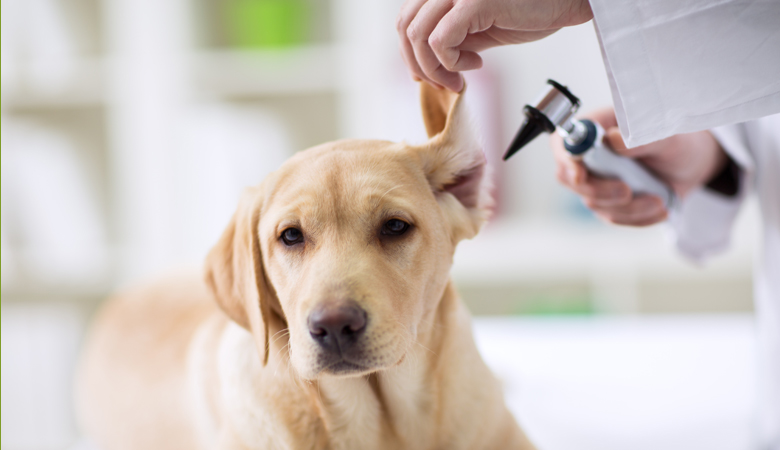Symptoms of an Ear Infection
Dogs with ear infections can have multiple symptoms:
- Itching or pain in one or both ears
- Head shaking
- Scratching the ears
- Warm ears
- Red ear flaps
- Unpleasant smell
- Visible wax or discharge in the ear canal
This earwax may look different depending on the type of inflammation and the microorganisms that may or may not be involved.
If you suspect your dog has an ear infection, always consult your vet. Not every infection is the same, and the right treatment depends on the cause. Your vet can look inside the ears and may take samples to view under a microscope. Sometimes the ears need to be cleaned before treatment can begin.
Causes of Ear Infections in Dogs
Ear infections are common in dogs and can have several underlying causes. The most common primary causes include:
- Ear mites
- Foreign objects like grass seeds
- Allergies
Secondary causes can also play a role, such as excess earwax, the dog’s ear structure, or frequent swimming. These factors create a moist environment where bacteria, yeast, and fungi thrive.
Ear Mites in Dogs
Ear mites are parasites that live in and around the ear, where they feed on earwax and skin flakes. They cause severe itching and discomfort for dogs. Ear mite infections are most commonly seen in puppies, but dogs of all ages can be affected. Because ear mites are highly contagious, all dogs (and cats) in the household should be examined. A vet can inspect the ear canal with an otoscope and may see the mites moving around. Due to an overproduction of dark brown earwax, it may be necessary to flush the ear canal before applying a mite-killing treatment. This condition will not go away on its own and must be treated. Treatment often consists of a combination of a spot-on product, such as Stronghold, and an ear cleaner like Clean Ear Cleaner, which helps to repel mites.
Grass seeds as a cause of ear infections in dogs
During the summer, tall wild grass produces seed heads known as grass seeds or awns. When a grass seed gets into the ear canal, it causes immediate irritation. This is not only very painful for the dog but also carries the risk of damaging the eardrum. The grass seed must be removed as soon as possible by a vet.
Allergic ear infections in dogs
The ear canal is lined with skin. Dogs with allergic skin problems often also suffer from ear inflammation. Sometimes, an ear infection is even the only visible symptom. Dogs can be allergic to substances in their environment (atopy) or to certain ingredients in their food — sometimes both. Once the allergy is under control, the ear infection usually resolves as well.
Read more about allergies in our blog Atopic dermatitis in dogs and cats.
Dog breeds with an increased risk of ear infections
Some dog breeds are more prone to ear infections than others. The reasons vary: some produce more earwax, others have heavy, drooping ears, lots of hair inside the ear canal, or very narrow ear canals.
Breeds that produce a lot of earwax
The Labrador Retriever and Cocker Spaniel are known for producing more earwax than average. Earwax itself is normal and plays a protective role. The ears have a natural cleaning mechanism that helps move old cells and wax out of the canal. If this mechanism becomes disrupted, problems can occur. A suitable product for dogs that produce a lot of earwax is Otoact.
Breeds with heavy, drooping ears
Dog breeds with heavy, drooping ears, such as the Bloodhound, Basset Hound, and Cocker Spaniel, are particularly prone to ear infections. The shape of their ears allows less air circulation, making it harder for moisture and wax to escape. This creates an ideal environment for bacterial growth. In Cocker Spaniels, the increased earwax production makes the problem even worse. These breeds therefore suffer more often from ear infections.
Breeds with a lot of hair in the ears
Dogs such as the Poodle, Lagotto Romagnolo, and Labradoodle often have a lot of hair in their ear canals. This can trap earwax and lead to matting, which increases the risk of infection. For these dogs, it is advisable to use an ear cleaner regularly. If ear problems occur frequently, it may help to have the excess hair in the ears carefully plucked by a professional. Do not do this preventively, and only let it be done by someone experienced, as plucking can irritate the ear canal and cause inflammation.
Breeds with narrow ear canals
The Shar-Pei, English Bulldog, French Bulldog, and Pug naturally have narrow ear canals, which increases the risk of problems. The Shar-Pei also has thickened skin, including inside the ear canal, which makes ear infections more likely.
What is a haematoma (blood ear)?
An aural haematoma, or “blood ear”, occurs when a dog shakes its head vigorously or scratches its ears excessively — often due to an ear infection or itching. Small blood vessels in the ear flap burst, causing blood to collect between the layers of skin. This results in a swollen, warm, and painful ear. Without treatment, scar tissue can form, leaving the ear permanently deformed or “crinkled”. Always contact your vet if your dog’s ear becomes swollen — early treatment can prevent lasting damage.
Can you prevent ear infections in dogs?
It’s not always possible to prevent your dog from developing an ear infection. It’s certainly not necessary to use ear drops or cleaners for every dog. Only dogs that frequently suffer from ear problems, such as those with allergies, excessive wax build-up, or certain ear shapes, may benefit from preventative cleaning with an ear drop or an appropriate cleaner.
Note: If your dog isn’t prone to ear issues, it’s not necessary to clean their ears preventively.
A dog’s hearing system is unique in many ways. When a dog suffers from ear problems, it can greatly affect their well-being. If in doubt, always consult your vet.
Do you have any questions? Contact us at veterinarian@vetsend.co.uk.







